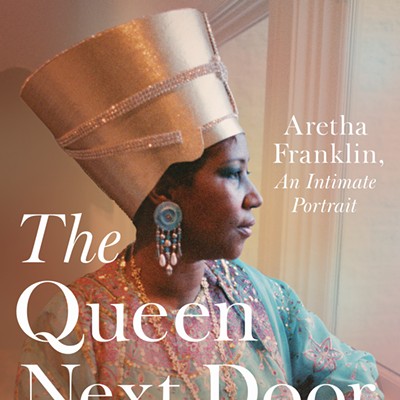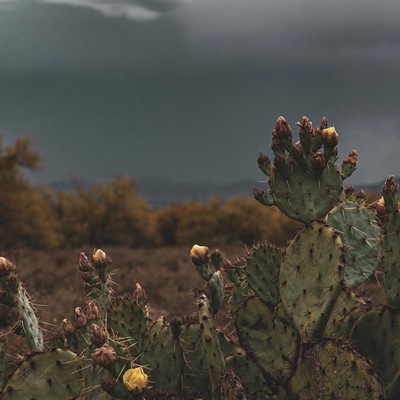The team was busy with its task--setting out water in the desert for border crossers--so Hyatt jotted down the saguaro's location, and the next morning, he drove back 100 miles to photograph it.
A 3-foot statue of the Virgin of Guadalupe stood at the base of the armless saguaro, near Quijotoa on Tohono O'odham land. A bandana printed with the image of the Virgin had been tacked with twigs to its trunk. And all kinds of trinkets--from rosary beads to fishing tackle--had been threaded among its thorns.
"It was fascinating," Hyatt says, and he was interested enough that he drove back to look at it again on Dec. 12, the feast of Guadalupe, patron saint of Mexico. This time, he found an O'odham elder who told him the cactus' tale. A local woman, the man said, thought that the saguaro looked like the Virgin, especially when flowers on its crown bloom in June. To honor this small miracle, the woman donated her big statue.
Soon, the many Mexican migrants passing by began decorating the saguaro like any shrine back home. They lit religious candles at its base, praying to Guadalupe for a safe journey through the perilous desert, and added secular lucky charms, like an 8-ball, for good measure. Others tacked on holy cards.
The bandana, imprinted not only with the Mexican Virgin but the American Statue of Liberty, is typical of those sold in Altar, the Northern Sonoran jumping-off point for migrant treks through the desert, Hyatt says. The two icons represent the starting point and hoped-for endpoint of the journey, but the cloth comes from elsewhere. It's imprinted with the words "Made in Taiwan," a reminder of the global economy that pushes economic refugees over borders worldwide.
"No wonder they're leaving Mexico," Hyatt says.
The fishing tackle strung over the ribs hints that some of the saguaro devotees were from a fishing village, especially since so many members of the flood heading north hail from the impoverished coastal state of Veracruz.
"I'm speculating," Hyatt acknowledges, "but the artifacts raise questions. They make you think about the migrant experience."
Hyatt's photograph of the sainted saguaro appears on the cover of his just-published book, Migrant Artifacts: Magic and Loss in the Sonoran Desert (Great Circle Books, $30). The book offers up 28 black-and-white images culled from the hundreds Hyatt has shot in the last four years during the course of his volunteer work with Humane Borders and the Samaritans. Though some portraits are included, the book concentrates on objects left behind--backpacks, a little girl's dress, a bra strung through branches in a tree.
This Saturday night, at Bohemia gallery, Hyatt kicks off a modest exhibition of seven of the photos with a book-launch party and signing. The book won't be available in regular bookstores until the fall; part of the proceeds from the early edition on sale at Bohemia will benefit Humane Borders and the Samaritans. (The Samaritans "drive around the back roads, providing food and medical aid" and calling the Border Patrol as needed.)
Host of the "traditional country" show Route 66 on KXCI FM 91.3 Tuesday nights, Hyatt makes no bones about his sympathy for the desert's undocumented wanderers. He met the Rev. Robin Hoover, founder of Humane Borders, at a benefit some years back and asked how he could help the effort to lower the annual toll of migrant deaths. "He told me, 'Document what we're doing.'"
Ever since, Hyatt has brought the camera along on his forays into the wilderness.
"We're citizens," he says. "We have the right to do what we're doing."
He's taken many portraits of the travelers, including "Migrant Father" and "Migrant Mother," both shot in Altar and both featured in the book. The young father, his face distorted by anxiety, cradles his baby in his arms. The mother stands alone, clutching a water bottle, looking bleak but determined. (The title deliberately reprises the name of Dorothea Lange's famous photo of a 1930s Dust Bowl refugee and her children.) Another touching image pictures a migrant on his knees, praying in a chapel in Altar, for safe deliverance.
But Hyatt's publisher, Rex Weiner, was more struck by the mute power of the objects left behind on the trails. As anyone traveling Southern Arizona knows, the migrant routes are littered with trash--water bottles, food cans--as well as more telling personal items.
"People are jaded by arrest photos," Hyatt says. "These artifact images go much deeper."
"Sandals From Another World," 2005, focuses on a worn pair of open-toed shoes woefully inadequate for a desert trek. Many of the migrants, Hyatt notes, hail from the tropics or the mountains and have no inkling of what the desert is like.
"They've never seen a cactus or experienced dryness. They're lied to by the coyotes--they'll tell them, 'Phoenix is right over that hill.' These shoes symbolize that lack of preparation."
Hyatt conceives of himself as a documentary photographer, in the tradition of his heroes Lange, Henri Cartier-Bresson and Russell Lee, but sometimes he changes what he finds, picking up the artifacts and repositioning them elsewhere. That's what he did with the sandals. He carried them around until he found a suitably cracked and baked crust of desert. Then he put the sandals one in front of the other, as though they're still walking.
Sometimes, though, the objects speak volumes exactly where he finds them. Such is the case with a startling photo of El Diario de Ana Frank ("Anne Frank in a Migrant Camp"). Hyatt came across the Spanish-language book as a member of a volunteer cleanup crew in Arivaca. Ranchers around the little town just north of the border routinely find trash from migrants littering their lands, and in an effort to ease tensions, activist Ila Abernathy spearheaded an effort to pick up the debris.
"I was walking along, and there it was, as though someone who had been reading it had to run," Hyatt says of the book. "It had rained the day before, and the pages were curled. It's not common for anyone to bring a book for a hike through the desert. Whoever was reading it must have felt some kinship" with the persecuted Anne Frank.
Anne's story of her family's struggle to stay alive ends badly, of course. The fate of the anonymous reader of the Spanish edition remains unknown.














